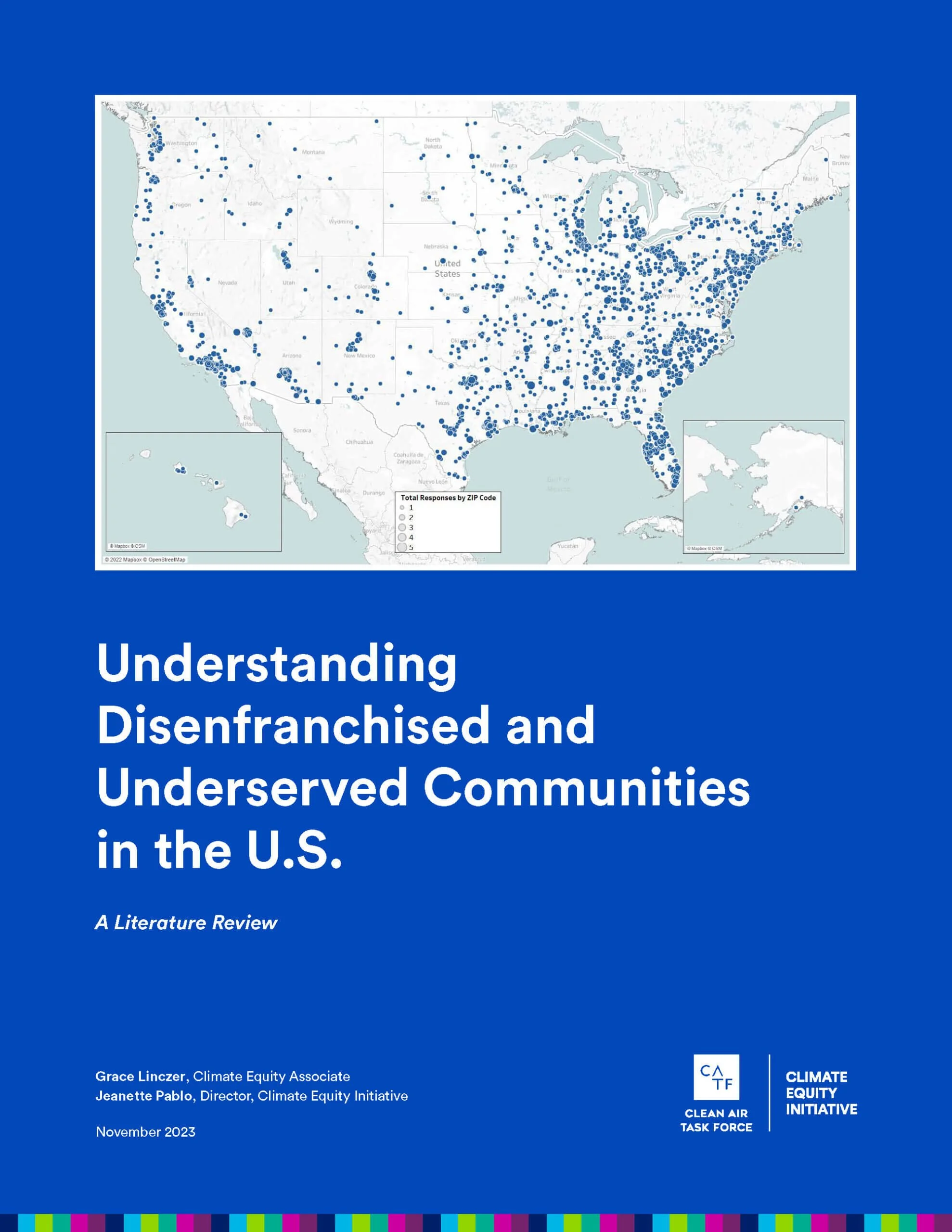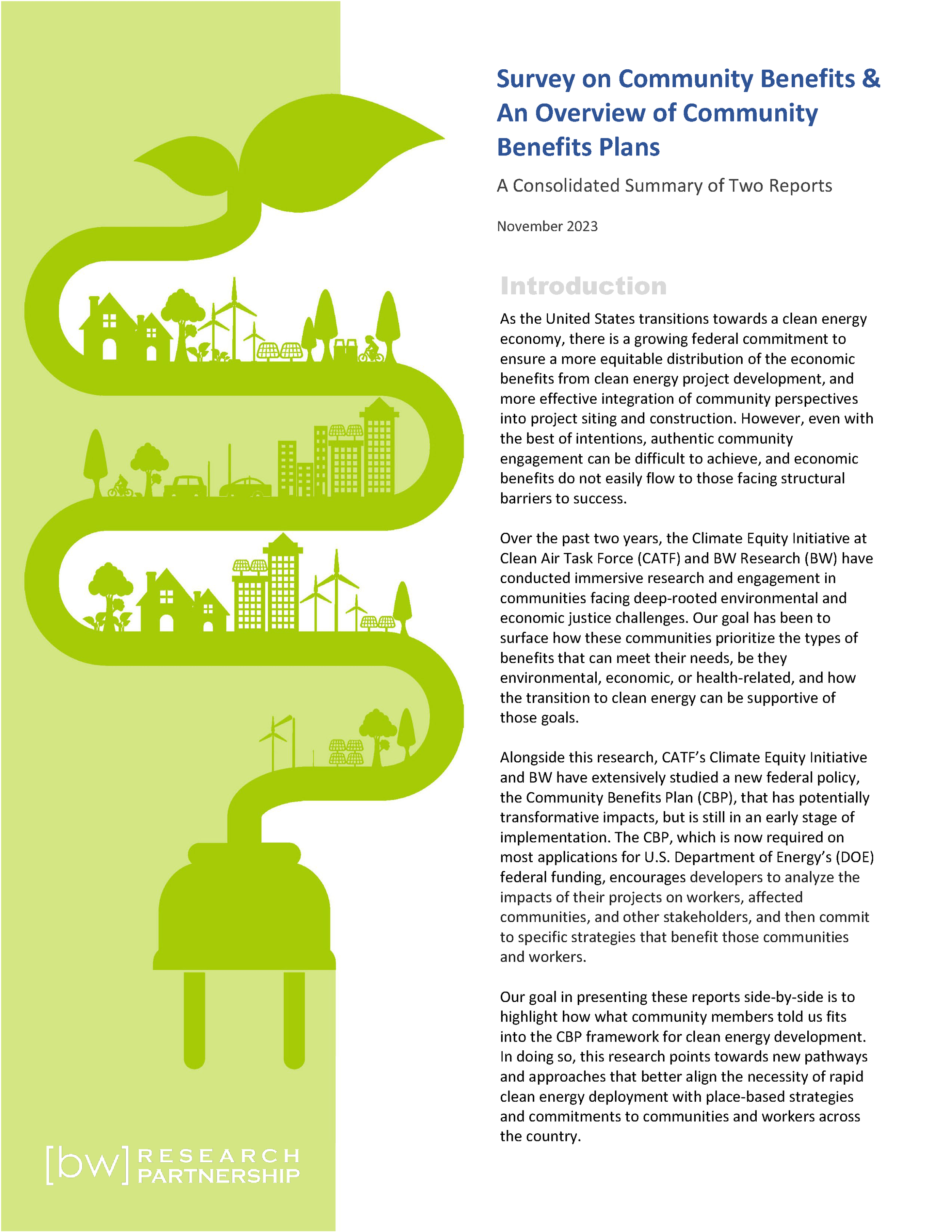Climate Equity Foundation Heritage
In May 2021, Clean Air Task Force (CATF) launched the Climate Equity Initiative led by Jeanette Pablo. The goal was to conduct research and analysis on effective ways to solve long-standing environmental justice issues as the “just” part of the clean energy transition which is central to the global effort to address climate change.
By working with environmental justice leaders, advocates, and community residents, the Initiative sought to:
Identify barriers, challenges, and potential opportunities in environmental justice communities;
Advocate for changes and the adoption of solutions to systemic barriers and challenges that create and perpetuate environmental injustice, particularly in the context of environmental and climate policies and practices; and
Ensure that CATF and other climate advocates achieve a better understanding of the needs and concerns of environmental justice communities, and, with their input, develop tools and initiatives to ensure communities have a powerful voice at the table in the transition to a just clean energy future.
Between May 2021 and spring of 2024, the Initiative produced sixteen reports and six short films. Yet, there still is much more work to be done and we have identified the need for an expanded scope. CATF decided the best course of action is to spin-off the Climate Equity Initiative into the newly formed Climate Equity Foundation to advance and expand our mission.
Below are the currently published reports produced by CATF’s Initiative, with CATF’s permission. The Climate Equity Foundation is grateful for CATF’s continued support. These reports can also be found on CATF’s website.
*Six reports and six short films are to be published in the late spring 2024.
Perspectives from Environmental Justice Communities: A National Survey
CATF commissioned BW Research Partnership to conduct a national survey of residents of environmental justice communities, based on self-declared race, ethnicity, and income.
The purpose of this national survey and report was to gain greater understanding of community perceptions regarding environmental justice and climate equity issues.
Read the report and watch the webinar.
Understanding Disenfranchised and Underserved Communities in the U.S.
This paper provides a broad overview of the challenges facing disenfranchised and underserved communities today, reflecting upon the compounding effects of inequity and the multifaceted nature of environmental risk.
While it is important to engage each community with regard to their unique challenges and history, this analysis demonstrates that the most salient issues facing disenfranchised and underserved populations today are those which threaten health, economic well-being, and overall prosperity. Any efforts to move towards a just, decarbonized economy must account for the real concerns of disenfranchised and underserved communities. Watch the webinar.
Consolidated Summary: Survey on Community Benefits and an Overview of Community Benefits Plans and Agreements
Since 2021, the Climate Equity Initiative at Clean Air Task Force and BW Research have conducted immersive research and engagement in communities facing deep-rooted environmental and economic justice challenges. Our goal has been to surface how these communities prioritize the types of benefits that can meet their needs and how the transition to clean energy can be supportive of those goals.
Alongside this research, CATF’s Climate Equity Initiative and BW have extensively studied a new federal policy, the Community Benefits Plan (CBP), that has potentially transformative impacts, but is still in an early stage of implementation. Our goal in presenting these reports side-by-side is to highlight how what community members told us fits into the CBP framework for clean energy development. In doing so, this research points towards new pathways and approaches that better align the necessity of rapid clean energy deployment with place-based strategies and commitments to communities and workers across the country. Watch the webinar.
Understanding Community Benefits Plans at the Department of Energy and Their Potential for Impact
The Community Benefits Plan (CBP) process is a first-of-its-kind effort at the Department of Energy (DOE) to leverage the opportunity for significant climate and clean energy funding to encourage a more equitable, place-based approach to project development. As part of completing a CBP, developers, and other grant applicants must research the impacts of their projects on workers, and affected communities, and then commit to specific strategies that address those impacts. By requiring a CBP for most DOE grant applications, the agency hopes to improve project viability by maximizing more equitable community and worker benefits from those projects. This report addresses Community Benefits Plans with a focus on the U.S. Department of Energy’s federal funding requirements.
Community Benefits: A Survey of Perspectives from Three Communities
As part of completing a Community Benefits Plan (CBP), developers must research the impacts of their projects on workers, affected communities, and community members, and then commit to specific strategies that support greater benefits to those workers and communities. Although constructive and well-intentioned, the community benefits plan process is still at an early-stage and, given its focus on developers, is at risk of not capturing and responding to the needs and preferences of communities where clean energy development is occurring. To learn more about these community preferences, the research team conducted surveys of residents of three communities: The Ironbound Community in Newark, New Jersey; St. James Parish & St. John the Baptist Parish, Louisiana; and The Nenahnezad Chapter, the Upper Fruitland Chapter, and the Shiprock Chapter, Navajo Nation.
Community Benefits Agreements: Case Studies, Federal Guidelines, and Best Practices
As billions of dollars in federal funds are allocated towards clean energy and decarbonization projects, community benefits agreements (CBAs) are emerging as a tool for improving projects’ environmental justice outcomes. CBAs are legal agreements between private sector project developers and community-based organizations, stipulating the benefits that a developer must provide to a community during and after project implementation. Done well, CBAs can be a powerful tool for achieving more equitable outcomes in energy development and decisionmaking. But done poorly, they can end up providing surface-level benefits that fail to address
long-standing community challenges or, worse, be used as an excuse to green light projects that further entrench environmental inequities. This report aims to bridge federal guidelines, developer understandings, and community priorities to support more equitable outcomes in CBA development and implementation.
Community Health Impacts of Air Pollution in the U.S.
This report identifies the largest sources of air pollution in the U.S., describes the health impacts of air pollution, and is followed by a summary of air emissions from the energy and transportation sectors. In addition, the report provides an overview of the Clean Air Act, including a description of some of its key programs and the pollutants regulated under the act, and discusses the successes of the Clean Air Act in improving air quality nationwide, while recognizing that disenfranchised and underserved communities bear a disproportionate share of the continuing burden of air pollution. Watch the webinar.







